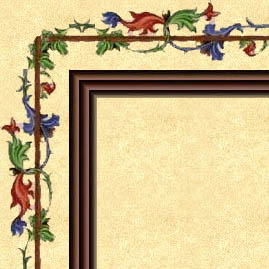


This section 'Help to create the feeling of a fifteenth century tournament' is based a lot on the text 'How a Man Shall Prepare Himself for the Tournament' by Will McLean. The authors permission to use this text has been granted for a previous version of this booklet. The original text can be found on the web at http://mqh.cit.cornell.edu/~mqh/st-mikes/tourney.html
Here are some suggestions that may be useful if you want to contribute to create a feeling of a fifteenth century tournament.
First, examine your harness. Is it of one consistent period? Can you find a picture of a medieval Knight that looks like you do? Are there glaring anachronisms? Few harnesses conceal enough of blue jeans to hide their essential nature. Dark sweat pants, with socks in a matching color, are better and hose are better still. Two-tone Nikes don't look very medieval. All black sneakers are better, and medieval shoes or sabattons are better still.
The right covering can conceal a multitude of sins. Essentially, you have two approaches. Before 1350, the armor was less challenging, but the surcoats were usually sleeveless, so they covered less of it. When sleeves were worn, they were rarely longer than elbow length. After 1350, the armor was more sophisticated, but garments called jupons or coat-armors, often with long sleeves, sometimes covered much of it. From 1400 on uncovered plate armor became increasingly popular. The later a period you choose, the more dependent you become on a good armorer.
According to King René's manual, the fighters should wear a short tabard displaying the fighter's device. The tabards shown in the manual are of the same type as the Burgundian heralds tabards, see picture below. The device should be shown both on the front and the back of the tabard, as well on both sleeves. The tabard should reach to mid-thigh when worn over the armour. Remember to make the tabard ca. 5-6 cm longer at the back.
To appear without a crest would have been unthinkable in many C15 tournaments, and we encourage you to wear one. How else will the demoiselles follow your valour in the melee? There was an excellent article on crest construction in TI #108. A leather cap, moulded to the shape of the top of the helmet, can be laced by through four pairs of holes to the helmet, and removed when convenient. This provides an good foundation for the crest. It is difficult to mount a crest and mantling on the pointed skull of an ordinary bascinet. There is no evidence that medieval gentleman ever did so. When they wanted to adorn a bascinet, the normal approach was to mount a gilded ball (called a pomme) at the apex, with several feathers springing from the top of that. For those who are unable through circumstance to bring a crest, the Company will have a supply of colourful feathers available.
From the 14th century on, great persons often equipped their followers in livery, that is distinctive clothing, either of distinctive colours of fabric, or distinguished by badges, or both. The colours might be the same as the lord's arms, or they might not, and the colours of clothing delivered to the lords followers might vary from year to year depending on the whim of the lord, the availability of fabric, and so on. Liveries were often parti-coloured, and sometimes tri-coloured. The colours were not restricted to the pure colours of heraldry. Other options included light green, tawny (orange-brown), russet (rusty red-brown) and murrey (purple-red, or mulberry colour). Liveries might consist of complete suites of clothing, sleeveless jackets, or sometimes simply hoods. Badges might be made from metal, appliqued, or embroidered. Popular locations included upon the sleeve or hat, the middle of the chest and back, or upon what would now be the lapel, usually on the wearer's left side. A noble that really wanted to show off at a tournament would put his retinue not simply into matching clothes, but into elaborate costumes. Besides the examples mentioned earlier, Claude de Vauldrey came to one 15th c. Burgundian tournament with a retinue of wildmen and wildwomen. Another had costumed moors in his train. This does present some opportunities for people with personas that aren't your standard late-middle ages West-European types. A Celt might come as "The King of Lyonesse" with a retinue in fringed cloaks, carrying Irish javelins. A Berber from the Maghreb might be followed by turbaned moors with nakers and kettledrums. (A real 15th century Burgundian doing this would of course try to find an elephant or pair of camels to add to the procession. Camels and elephants are also available for hire in modern Europe...) The ideal thing would be to really push it over the edge, so that instead of just being a Scadian with knotwork on your shield, you look like a Burgundian that decided it would be impressive to outfit his entire following in Arthurian fancy dress. The greater nobles would often bring several men-at-arms as part of their following, to fight beside them in the tourney. For this tourney however, we have limited the number of followers (see Special Rules).